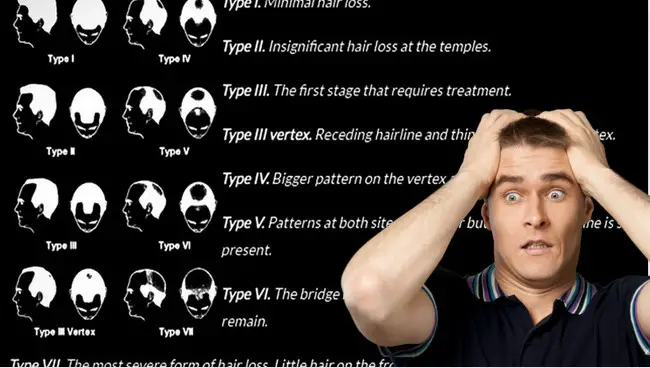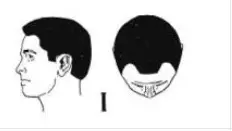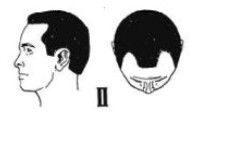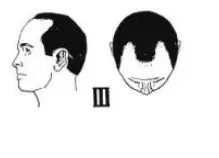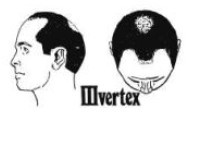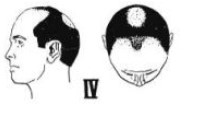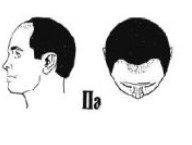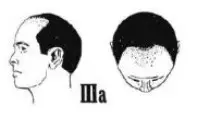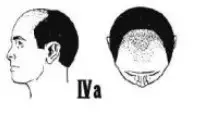The Norwood Scale is a standardized scale for male pattern baldness, developed by Dr. O’Tar Norwood in 1971. It is used to measure the progression of hair loss and to determine the most appropriate treatment option.
The scale is divided into several stages, with Nw1, Nw2, and Nw3 hair loss stages easily managed with the right hair loss treatment.
To accurately measure Norwood 3 hairline progression on the Norwood Scale, it’s necessary to have a baseline image of what your scalp would look like if you had no hair loss at all. This baseline image can be taken when you are in Stage I or Stage II on the scale, which is considered a sound stage with no noticeable progression of hair loss.
What is the Nw3 Hair?
The Norwood 3 hairline (known as Nw3 Hair) is the stage of hair loss where the hairline recedes to the forehead. It is typically characterized by a receding hairline and frontal balding.
Receding Hairlines Chart
This receding hairline chart below eventually merges into one continuous, uninterrupted crown of your head balding area. Where the “front to back” is visible in the image.
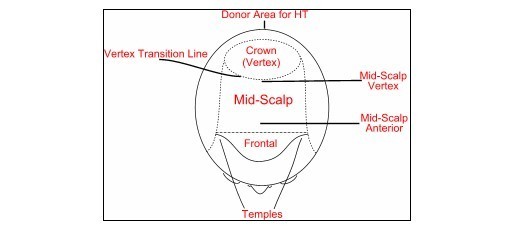
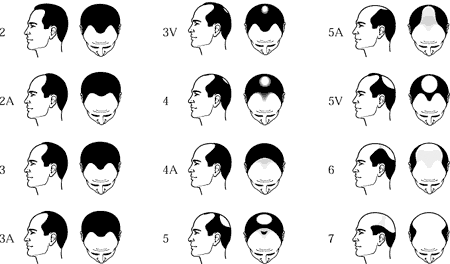
Facts:
There is no hair growth in a balding region on the vertex simultaneously. A bald spot on the vertex does not appear at the same time. Instead, the anterior recession keeps increasing posteriorly to the vertex (crown). This isn’t to suggest that type a variant hairlines males don’t experience balding at the crown. It just happens toward the end front of the forehead template. With either Type, one’s eventual balding pattern may be predicted overall general by noticing where they’re at, following the logical progression.
Men’s hairline types

These types of hairlines on the temples are:
1. Regular Type
This is the predominant type of receding hairline in 97 percent of all 1,000 men that Hamilton reviewed, using the Norwood hair loss scale to log the details. The Regular Type of hairline shows baldness at the crown in the Norwood 3 hairline stage, which is noticeable with hair loss and thinning on temples, also called the Norwood 3 Vertex.
|
Norwood hair loss Chart |
Description of |
Type: Nw1 hairline
|
This normal low hairline (Norwood 1 hairline) closely resembles boys in their teenage years or young men. There is no temporal recession, hair loss, or minimal temporal recession of the hairline. |
Type: Nw2 hairline
|
This Norwood 2 Hair type begins to recede above the temples to a point no greater than 2 cm from the mid-frontal peak, which might also decrease slightly, leaving a higher forehead. |
Type: Nw3 hairline
|
This type of hair loss is Norwood 3 hairline represents the minimal extent of hair loss, considered sufficient to describe crown baldness,” wrote Dr. O’Tar Norwood. Most types of class 3 hair loss on the scalps have a deeper temporal recession, greater than 2 cm, and higher mid-frontal hair loss, leaving a higher forehead. |
Type: Nw3 vertex
|
In this type of hair loss is Norwood 3 vertex, the receding hairline is primarily in the vertex shape crown of head hair loss with possibly some frontal hairline recession but does not exceed like seen in Nw3 hair type above. “This type of balding or male pattern baldness is most common with older age men.” |
Type: Nw4 hairline
|
Norwood 4 is further, frontal hairline and temporal hair loss are more severe than type Norwood 3 hair vertex. “Also, there is a small percentage or lack of hair on the crown area. These areas are extensive hair loss, but separated from each other by a band of moderately dense hair that extends across the top.” |
2. Type A Variant
This type of variant hairlines receding constituted the other 3 percent of men in the scientific study. It is distinguished by two major features and two minor features.
All the essential characteristics must be present in the type A variant hairlines in male classification. The minor features are not necessary but are frequently present.
|
Norwood hair loss Chart |
Description of The entire hairline’s anterior scalp and frontal border progress posteriorly without leaving the usual island or peninsula of hair in the mid-frontal region, where there is no simultaneous development of a bald area on the vertex. |
Norwood 2a
|
The entire frontal border, with temples, lays high on the forehead. That mid-frontal peninsula or peak of the hair on the forehead is gone and only represented by a few fines and vellus hairs on the scalp, where recession is less than 1 inch. |
Norwood 3a
|
This uneven hairline area of the recession of the frontotemporal region is almost vertical with the front portion of the ear. |
Norwood 4a
|
The area of recession is now past the front portion of the ear. The site behind the hairline may show thinning and fine vellus hair on the scalp. |
Norwood 5a
|
This is the most advanced degree of alopecia described with this type of variant hairline. If it becomes more extensive, it cannot be distinguished from regular male pattern baldness stages 6 and 7. But the area of alopecia has not reached the vertex as yet. |
Nw3 hair transplant
Hair transplants are a common treatment to correct Nw3 hair loss, but the type of transplant can be costly. The Norwood scale is often used to determine which type of hair restoration procedure is best for you.
But should I get a hair transplant at Norwood 3?
FAQ
Is uneven hairline normal?
It is normal for a person’s hairline to be uneven. There are many reasons, including genetics, age and certain hair products. As you grow older, your hairline will recede because of the natural aging process. The most common cause of an uneven hairline is when one side of your head has significantly more hair than the other side. This can happen due to genetics or to losing more hair from one side of your head than the other due to stress or illness.
Can Norwood 3 stop balding?
Yes, balding can be stopped and treatable with regrowth devices (LLLT) to help restore hair growth if you have NW3 hair loss. The Norwood scale, a classification system for male pattern baldness, measures alopecia on a scale of 1 to 7.
How do you style a Norwood 3?
The Norwood 3 hairstyle is a popular choice for hiding the bald spot on the crown for men who want to keep their hair short. It is also known as the low-fade haircut, and buzz haircut fade.
There are many different ways to style this haircut. The most popular ones are:
Step 1: Do a comb over and the quiff hairstyle.
Step 2: The comb over is achieved by brushing the hair back and then styling it with a product such as pomade or gel.
Step 3: The modern quiff hairstyle is achieved by using a blow-dryer to style it in that direction to cover up bald hair patches and then adding some product such as pomade or gel.
Who can Use the Norwood Scale?
The Norwood Scale is a medical device that is used to measure the progression of male pattern baldness.
The Norwood Scale was created by Dr. James B. Norwood in 1983, and it is the most commonly used scale for measuring people suffering from hair loss. This scale has been updated several times since its inception, and there are 7 different stages of hair loss. The scale ranges from stage 1, which represents no more than 20% hair loss, to stage 7, which represents 100% hair loss.
Related Post:
- AI Powered Bald Filter Online 2024: See Yourself with No Hair! - January 19, 2024
- Harklinikken Bad Reviews 2024: Analyzing Negative Feedbacks - January 18, 2024
- How to Get the Alex Eubank Hair | Step-By-Step Tutorial 2024 - January 18, 2024

